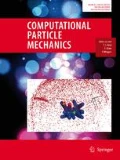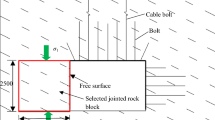Abstract
With the increase in the number of rock engineering projects, it has been recognized that the influence of joints on compressive damage of rock mass cannot be ignored. The existence of joints in the rock mass having complex surface configurations significantly influences its damage properties. Hence, a particle flow code (PFC2D) was used to investigate the effects of joint surface configuration on mechanical properties of jointed rock when compressed. In this study, a hybrid model with parallel bond model (PBM) and flat-joint model (FJM) was applied to simulate granite material and the complex surface configuration was simplified into four types of shapes (i.e., rectangle, trapezoid, ellipse and triangle). The shape effect on deformation and failure modes of jointed rock was discussed. The numerical results show that joint asperity diminished mechanical property of jointed rock and is prone to damage. It is reflected that strength and elastic modulus markedly decreased and asperity degradation. In addition, because of the asperity asynchronous degradation, the joint surface exhibited inconsistent displacement. The joint asperity shape affected the failure properties of jointed rock. Three failure modes of the joint asperities were observed. Finally, the shape feature of the asperities (angle, radius ratios and side length) on the deformation and degradation of joint asperity was discussed.















Similar content being viewed by others
References
Hoek E (1983) Strength of jointed rock masses. Geotechnique 33:185–223. https://doi.org/10.1680/geot.1983.33.3.187
Yan Y, Li J (2021) Experimental study on the influence of joint roughness and matching state on dynamic compression characteristics of rock masses Chin J Rock Mech Eng 40: 1132–1144 http://rockmech.whrsm.ac.cn/CN/Y2021/V40/I6/1132
Bobet A, Einstein HH (1998) Fracture coalescence in rock-type materials under uniaxial and biaxial compression. Int J Rock Mech Min Sci 35:863–888. https://doi.org/10.1016/S0148-9062(98)00005-9
Morgan SP, Johnson CA, Einstein HH (2013) Cracking processes in Barre granite: fracture process zones and crack coalescence. Int J Fract 180:177–204. https://doi.org/10.1007/s10704-013-9810-y
Feng P, Dai F, Liu Y, Xu NW, Zhao T (2018) Effects of strain rate on the mechanical and fracturing behaviors of rock-like specimens containing two unparallel fissures under uniaxial compression. Soil Dyn Earthq Eng 110:195–211. https://doi.org/10.1016/j.soildyn.2018.03.026
Cao RH, Cao P, Lin H, Pu CZ, Ou K (2016) Mechanical behavior of brittle rock-like specimens with pre-existing fissures under uniaxial loading: experimental studies and particle mechanics approach. Rock Mech Rock Eng 49:763–783. https://doi.org/10.1007/s00603-015-0779-x
Wu W, Gong F and Jiang Q (2022) Strength-weakening effect of high static pre-stressed granite subjected to low frequency dynamic disturbance under uniaxial compression. Trans Nonferrous Metals Soc China. https://kns.cnki.net/kcms/detail/43.1239.TG.20211222.1723.024.html
Zhu QQ, Li DY, Han ZY, Li XB, Zhou ZL (2019) Mechanical properties and fracture evolution of sandstone specimens containing different inclusions under uniaxial compression. Int J Rock Mech Min Sci 115:33–47. https://doi.org/10.1016/j.ijrmms.2019.01.010
Wang CX, Zhang SC, Zhang BC, Sun J, Chen LL (2020) Failure characteristics and physical signals of jointed rock: an experimental investigation. Arab J Geosci 13(14):1–10
Bobet A, Einstein HH (1998) Numerical modeling of fracture coalescence in a model rock material. Int J Fract 92:221–252. https://doi.org/10.1023/A:1007460316400
Bandis SC, Lumsden AC, Barton NR (1983) Fundamentals of rock joint deformation. Int J Rock Mech Min Sci 20:249–268. https://doi.org/10.1016/0148-9062(83)90595-8
Xia CC, Yue ZQ, Tham LG, Lee CF, Sun ZQ (2003) Quantifying topography and closure deformation of rock joints. Int J Rock Mech Min Sci 40:197–220. https://doi.org/10.1016/S1365-1609(02)00134-X
Matsuki K, Wang EQ, Giwelli AA, Sakaguchi K (2008) Estimation of closure of a fracture under normal stress based on aperture data. Int J Rock Mech Min Sci 45:194–209. https://doi.org/10.1016/j.ijrmms.2007.04.009
Misra A, Marangos O (2011) Rock-joint micromechanics: relationship of roughness to closure and wave propagation. Int J Geomech 11:431–439. https://doi.org/10.1061/(ASCE)GM.1943-5622.0000021
Tang ZC, Liu QS, Xia CC, Song YL, Huang JH, Wang CB (2014) Mechanical model for predicting closure behavior of rock joints under normal stress. Rock Mech Rock Eng 47:2287–2298. https://doi.org/10.1007/s00603-013-0499-z
Kulatilake P, Shou G, Huang TH, Morgan RM (1995) New peak shear-strength criteria for anisotropic rock joints. Int J Rock Mech Min Sci Geomech Abstr 32:673–697. https://doi.org/10.1016/0148-9062(95)00022-9
Jiang Y, Li B, Tanabashi Y (2006) Estimating the relation between surface roughness and mechanical properties of rock joints. Int J Rock Mech Min Sci 43:837–846. https://doi.org/10.1016/j.ijrmms.2005.11.013
Ge YF, Tang HM, Eldin M, Wang LQ, Wu Q, Xiong CR (2017) Evolution process of natural rock joint roughness during direct shear tests. Int J Geomech 17(5):E4016013
Tian WL, Yang SQ, Hu ZL, Lu JW (2020) Experimental study of the mechanical behavior of unfilled rough jointed specimens under uniaxial compression. Arab J Geosci 13(4):1–11
Li X, Pan C, Li X, Shao C, Li H (2022) Application of a synthetic rock mass approach to the simulation of blasting-induced crack propagation and coalescence in deep fractured rock. Geomech Geophys Geo-Energy Geo-Res 8:57. https://doi.org/10.1007/s40948-022-00376-4
Mohammadnejad M, Liu H, Chan A, Dehkhoda S, Fukuda D (2021) An overview on advances in computational fracture mechanics of rock. Geosyst Eng 24:206–229. https://doi.org/10.1080/12269328.2018.1448006
Zhang XP, Wong LNY (2013) Loading rate effects on cracking behavior of flaw-contained specimens under uniaxial compression. Int J Fract 180:93–110. https://doi.org/10.1007/s10704-012-9803-2
Castro-Filgueira U, Alejano LR, Arzúa J, Mas Ivars D (2016) Numerical simulation of the stress-strain behavior of intact granite specimens with particle flow code ISRM International Symposium–Eurock 2016, pp 2016-065.
Sun W, Wu SC, Zhou Y, Zhou JX (2019) Comparison of crack processes in single-flawed rock-like material using two bonded-particle models under compression. Arab J Geosci 12(5):1–15
Wong LNY, Peng J (2020) Numerical investigation of micro-cracking behavior of brittle rock containing a pore-like flaw under uniaxial compression. Int J Damage Mech 29:1543–1568. https://doi.org/10.1177/1056789520914700
Wang X, Yuan W, Yan Y, Zhang X (2020) Scale effect of mechanical properties of jointed rock mass: A numerical study based on particle flow code. Geomech Eng 21:259–268
Potyondy DO (2012) A flat-jointed bonded-particle material for hard rock.In: 46th U.S. Rock Mechanics/Geomechanics Symposium, pp ARMA-2012–501.
Barton N, Choubey VD (1977) The shear strength of rock joints in theory and practice. Rock Mech 10:1–54. https://doi.org/10.1016/0148-9062(76)90003-6
Chen X, Liao Z, Peng X (2012) Deformability characteristics of jointed rock masses under uniaxial compression. Int J Min Sci Technol 22:213–221. https://doi.org/10.1016/j.ijmst.2011.08.012
Author information
Authors and Affiliations
Corresponding author
Ethics declarations
Conflict of interest
The authors declare that they have no conflict of interest.
Additional information
Publisher's Note
Springer Nature remains neutral with regard to jurisdictional claims in published maps and institutional affiliations.
Rights and permissions
About this article
Cite this article
Yan, Yt., Wang, Sw. Simulation investigation of mechanical and failure characteristics of jointed rock with different shapes of joint asperities under compression loading. Comp. Part. Mech. 10, 45–59 (2023). https://doi.org/10.1007/s40571-022-00477-7
Received:
Revised:
Accepted:
Published:
Issue Date:
DOI: https://doi.org/10.1007/s40571-022-00477-7




